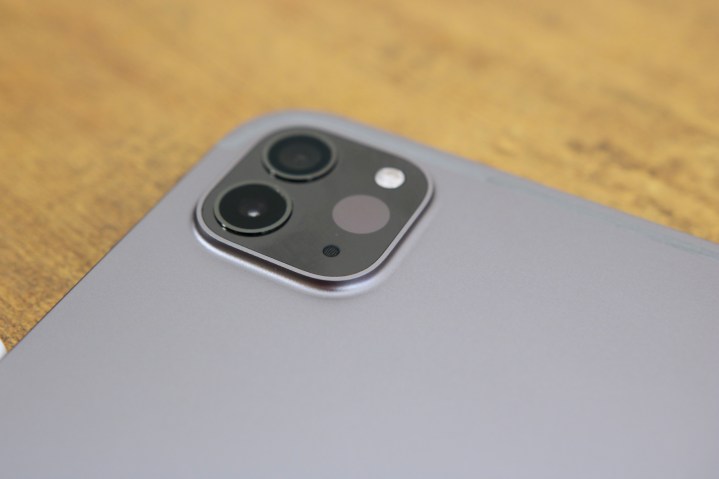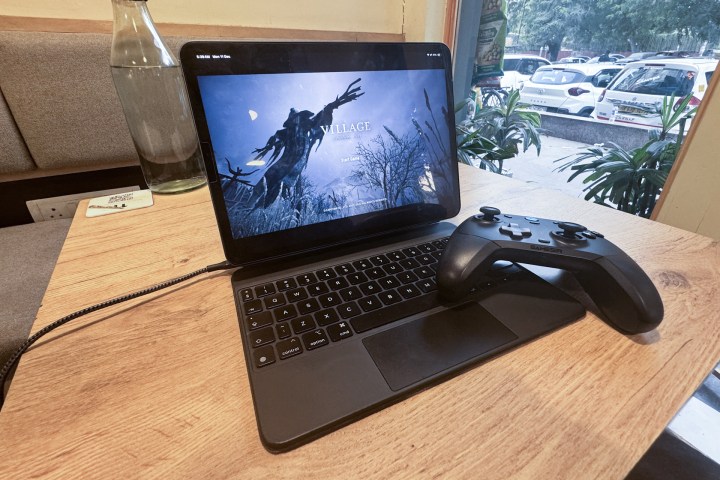
After years of waiting, Apple finally delivered what many are calling the ultimate form of the iPad Pro. The 2024 refresh of the iPad Pro is no regular iterative update. In fact, it even leapfrogs the Mac by serving as the introductory platform for next-gen silicon. It is the thinnest machine Apple has made so far, and it truly looks breathtaking from an engineering perspective.
- iPad Pro (2024) vs. iPad Pro (2022): specs
- iPad Pro (2024) vs. iPad Pro (2022): design and display
- iPad Pro (2024) vs. iPad Pro (2022): performance
- iPad Pro (2024) vs. iPad Pro (2022): cameras and battery
- iPad Pro (2024) vs. iPad Pro (2022): price and availability
- iPad Pro (2024) vs. iPad Pro (2022): Is it worth upgrading?
The new iPad Pro also has an OLED screen, and to go with it, Apple has introduced a new keyboard accessory that chases the MacBook’s best tricks. If that wasn’t enough, Apple also announced the best stylus it has ever made. On the not-so-pleasant side of things, there’s a $200 price hike, which is made worse by some controversial memory upgrade choices that are now tied to the M4 processor.
The jump between two iPad Pro generations has never been so stark, which spurs questions of whether you should upgrade and does your workload justify it. Following is a comparison between the 2024 iPad Pro and its M2-powered predecessor that offers crucial parameters to help you make an informed decision.
iPad Pro (2024) vs. iPad Pro (2022): specs
| iPad Pro (2024) | iPad Pro (2022) | |
| Size | 11-inch 9.83 x 6.99 x 0.21 inches (249.7 x 177.5 x 5.3 mm) 13-inch 11.09 x 8.48 x 0.20 (281.6 x 215.5 x 5.1 mm) |
11-inch: 9.74 x 7.02 x 0.23 inches (247.6 x 178.5 x 5.9 mm) 12.9-inch: 11.04 x 8.46 x 0.25 inches (280.6 x 214.9 x 6.4 mm) |
| Weight | 11-inch: 0.98 pounds (444 grams) 13-inch: 1.28 pounds (579 grams) |
11-inch: 1.03 pounds (466 grams) 12.9-inch: 1.5 pounds (682 grams) |
| Screen size |
11-inch: Ultra Retina XDR display/Tandem OLED
13-inch: Ultra Retina XDR display/Tandem OLED
|
11-inch Liquid Retina display 12.9-inch Liquid Retina XDR display |
| Screen resolution | 11-inch: 2420 x 1668 resolution at 264 ppi 13-inch: 2752 x 2064 resolution at 264 ppi |
11-inch: 2388 x 1668 resolution at 264 ppi 12.9-inch: 2732 x 2048 resolution at 264 ppi |
| Brightness |
SDR brightness: 1000 nits max
XDR brightness: 1000 nits max full screen, 1600 nits peak (HDR content only)
|
SDR brightness: 600 nits max XDR brightness: 1,000 nits max full screen, 1,600 nits peak (HDR content only) |
| Operation system | iPadOS 17 | iPadOS 17 |
| Storage space | 256GB, 512GB, 1TB, 2TB | 128GB, 256GB, 512GB, 1TB, 2TB |
| Processor | M4 chip with 16-core Neural Engine, up to 10-core CPU, 10-core GPU | M2 chip with 16-core Neural Engine, 8-core CPU, 10-core GPU |
| RAM | 256GB/512GB: 8GB RAM 1TB/2TB: 16GB RAM |
8GB RAM on models with 128GB, 256GB or 512GB storage 16GB RAM on models with 1TB or 2TB storage |
| Camera | 12MP Wide camera Landscape 12MP Ultra Wide Front Camera |
12MP Wide camera 12MP Ultra Wide Front Camera |
| Video | 4K video, ProRes | 4K |
| Bluetooth | Bluetooth 5.3 | Bluetooth 5.3 |
| Ports | USB‑C connector with support for Thunderbolt / USB 4 | USB‑C connector |
| Authentication | Face ID | Face ID |
| SIM card | eSIM | eSIM |
| Audio | Four speaker audio Four studio-quality microphones |
Four stereo speakers Five studio-quality microphones |
| Battery life | Up to 10 hours of surfing the web on Wi-Fi or watching video | Up to 10 hours of surfing the web on Wi-Fi or watching video |
| Network | Wi-Fi 6E / 5G Cellular | Wi-Fi 6E / 5G Cellular |
| Apple Pencil support | Apple Pencil Pro Apple Pencil (USB-C) |
Apple Pencil 2 Apple Pencil (USB-C) |
| Magic Keyboard support | Magic Keyboard for iPad Pro (M4) | Magic Keyboard |
| Colors | Space Black, Silver | Silver, Space Gray |
| Price | 11-inch: from $999 13-inch: from $1,299 |
11-inch: from $799 12.9-inch: from $1,099 |
iPad Pro (2024) vs. iPad Pro (2022): design and display

Apple is once again relying on 100% recycled aluminum for the iPad Pro, but this time, the difference is stark. Tipping the scales at just 579 grams and with a thickness of 5.1mm, the new iPad Pro is being marketed as the thinnest slate Apple has ever made. For comparison, the corresponding 13-inch iPad Pro from 2022 is 6.4 millimeters thick.
It’s astounding to see that the new iPad Pro is dramatically thinner than the Apple Pencil, but still retains the magnetic charging system for the stylus. To achieve that thin profile, Apple even had to shrink the camera bump, which entailed the departure of the ultrawide camera at the back. An interesting downgrade is also in tow. The 2025 version comes with a 4-mic array, while the 2022 trim comes armed with five mics.

The most notable change, one that shoppers will notice at first glance, is the display tech. After years of rumors and speculation, Apple has finally put an OLED display on the iPad Pro. And unlike the previous generation where the mini-LED display was reserved for the 13-inch model while the 11-inch version was limited to an LCD screen, the 2024 generation doesn’t make any such distinction, with both sizes getting OLED.
The pixel density remains the same, and so does the peak brightness output of 1,600 nits. However, Apple touts typical OLED benefits such as more precise contrast, better color reproduction, and double the contrast ratio. For the first time, Apple is also offering the option of nano-textured glass that dramatically reduces the display glare — at a price, of course.
There is another peculiar limitation here. The new iPad Pro only supports the Apple Pencil Pro and recently launched Apple Pencil with USB-C. That means if you have any other stylus lying around, including the Apple Pencil 2, you will have to splurge more money on a compatible stylus. This lack of backward compatibility could really grind the gears for many potential enthusiasts eyeing an upgrade.
iPad Pro (2024) vs. iPad Pro (2022): performance

At the center of Apple’s 2024 iPad Pro marketing ploy is the new M4 silicon. It’s darn surprising to see that Apple chose a tablet to introduce a next-gen processor, one that is going to appear inside Mac hardware in multiple formats and variants. Based on TSMC’s second-generation 3nm process, the latest M-series silicon takes the number of CPU cores to 10, up from eight CPU cores on the M2 generation.
But before we get into the performance comparisons, here’s what you should keep in mind. For the first time, Apple is offering a tablet-bound M-series silicon in two flavors, just the way it serves the processors inside MacBooks based on the number of GPU cores. In this case, you need to spend on the 1TB storage configuration to get the M4 version with 10 CPU cores. If you are eyeing the variants with 256GB or 512GB of onboard storage, you get the M4 trim with 9 CPU cores and half the amount of RAM (8GB).
Now, let’s talk performance. For the first time, courtesy of the M4 silicon, the iPad Pro is getting perks like hardware-accelerated ray tracing (great news for AAA games), dynamic caching, and hardware-accelerated mesh shading. At the heart of the silicon are four performance cores and up to six efficiency cores, tagging alongside a graphics engine with 10 GPU cores.

Apple claims the M4 offers a 50% performance boost over the M2 and is up to four times faster at graphics-intensive workflows. On the efficiency front, the M4 is said to match the M2’s performance while consuming half the power. But this wouldn’t be a new silicon introduction in 2024 without some grand AI talk.
Peaking at 38 trillion operations per second (TOPS) and armed with Machine Learning accelerators, the dedicated Neural Engine chip on the M4 is said to be 60x faster compared to the A11 Bionic. Thanks to the firepower at its disposal, Apple notes that the M4’s neural processing unit (NPU) will run “powerful diffusion and generative AI models” locally, apparently in the same vein as Google’s Gemini model running on Pixel 8 series phones. The NPU also speeds up a healthy bunch of demanding tasks and iPadOS experiences such as Visual Lookup, Live Captions, subject separation within
iPad Pro (2024) vs. iPad Pro (2022): cameras and battery

Apple is promising 10 hours of web surfing time on a single charge as the benchmark for iPad Pro battery life, which is the same as the 2022 generation. But there’s some peculiar changes to the battery. The 13-inch trim has seen its battery capacity go down from 40.88 watt-hours to 38.99 watt-hours, while the 11-inch variant has gone up from 28.65 watt-hours to 31.29 watt-hours.
In the imaging department, the 2024 iPad Pro features a single 12-megapixel camera at the back, while the 2022 variants also come equipped with a 12MP ultrawide snapper. Camera capabilities remain identical across both generations, but the most notable difference is support for AV1 decoding on the 2024 models courtesy of the next-gen media engine on the M4 silicon.
On that front, Apple has changed the camera position, going from portrait first to horizontal oriental for the sensor placement. This is a convenient change, especially for folks who rely on the iPad Pro as a computing machine perched atop a keyboard accessory like the Magic Keyboard or any of its cheaper third-party alternatives.

Talking about keyboards, there’s some wallet-friendly news this time. The price remains unchanged, but the refreshed Magic Keyboard now offers an aluminum-clad chassis that looks and feels more premium. Hopefully, it also solves the peeling problem that has plagued Magic Keyboard accessories so far.
The new Magic Keyboard also gets a function key row (complete with a dedicated Escape button) and supports haptic feedback on the glass-topped trackpad.
iPad Pro (2024) vs. iPad Pro (2022): price and availability

With all the upgrades that the new-generation flagship slates have to offer, Apple is charging a generation-over-generation premium of $200 for the 2024 iPad Pros. The 11-inch model starts at $999, while the 13-inch variant goes for $1,199 for the base storage configuration. Of course, the outrageous price premium for storage upgrades is here to stay.
And this time around, the stakes are higher, because unless you pay for the 1TB (or higher) storage variant, you will be limited to a low-power M4 variant with 9 CPU cores and 8GB of
iPad Pro (2024) vs. iPad Pro (2022): Is it worth upgrading?

On the surface, the 2024 iPad Pro is the biggest overhaul Apple has given to any product in recent memory. If a sleek build and reduced weight don’t matter much to you, the two key aspects that should inspire your purchase are the OLED screen and the M4 processor.
An OLED panel is, of course, great for media consumption. For creative professionals, especially for video editors and sketching workflows, an OLED screen delivers a meaningful visual upgrade. But it’s the M4 silicon that really stands as the key differentiator, especially with an NPU that will lay the foundations of AI-driven tasks.
Apple says the updated Neural Engine already proves its mettle at on-device chores, as well as hardcore workflows like video editing in Final Cut Pro. But the true potential is yet to be revealed, and for that, we’ll have to wait until Apple’s Worldwide Developers Conference (WWDC) to find out what AI-centric enhancements Apple has been cooking up for iPadOS to truly lift the iPad’s credentials.



